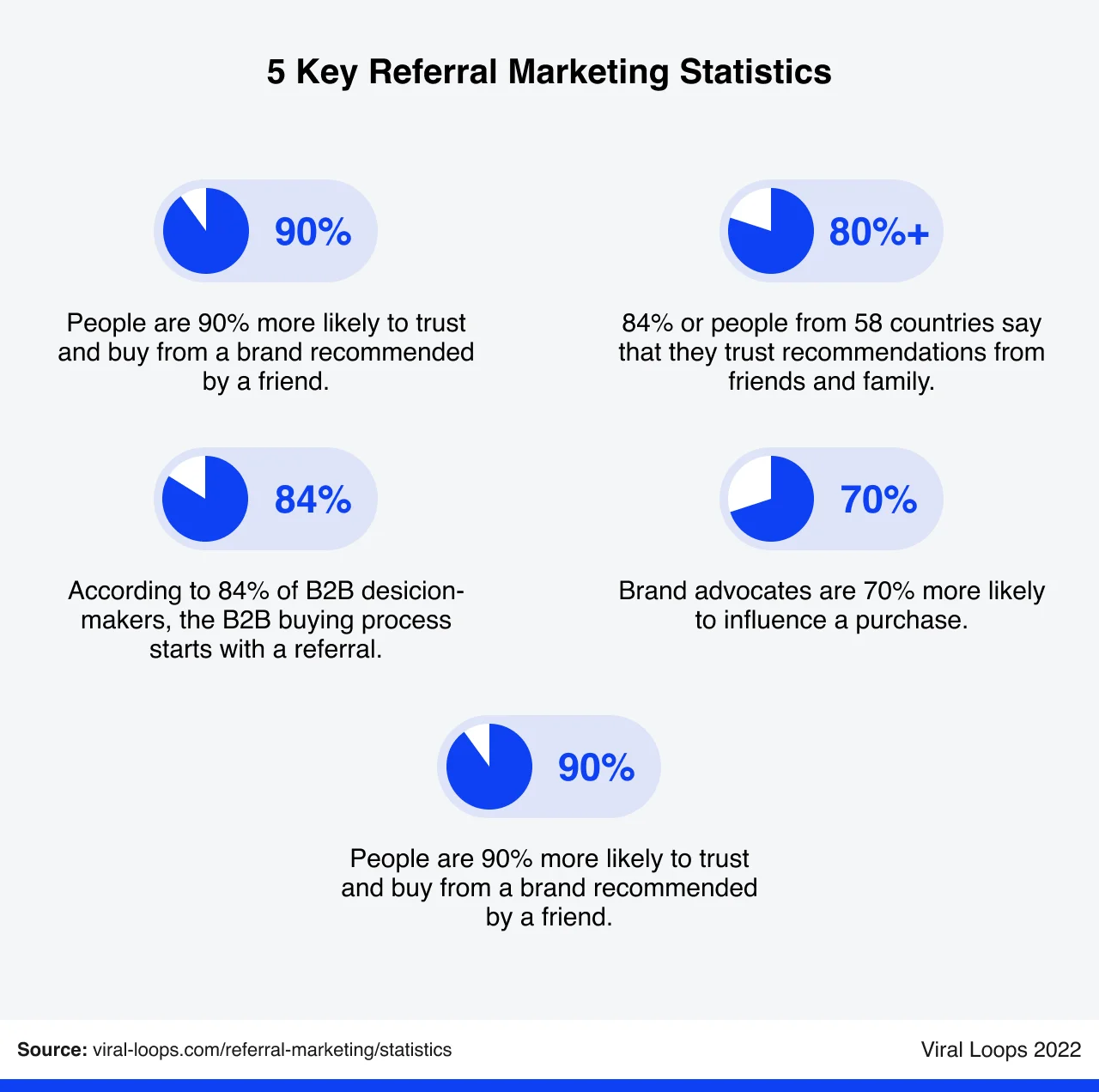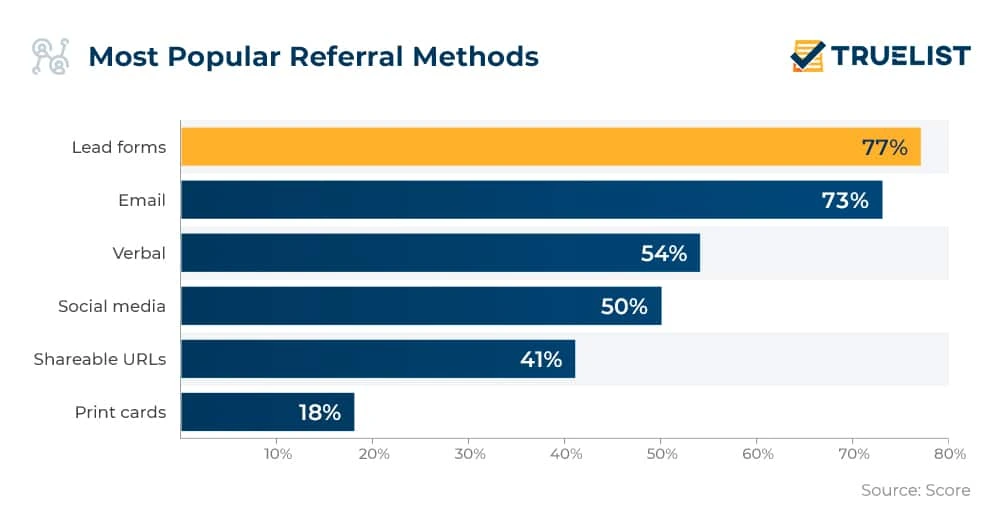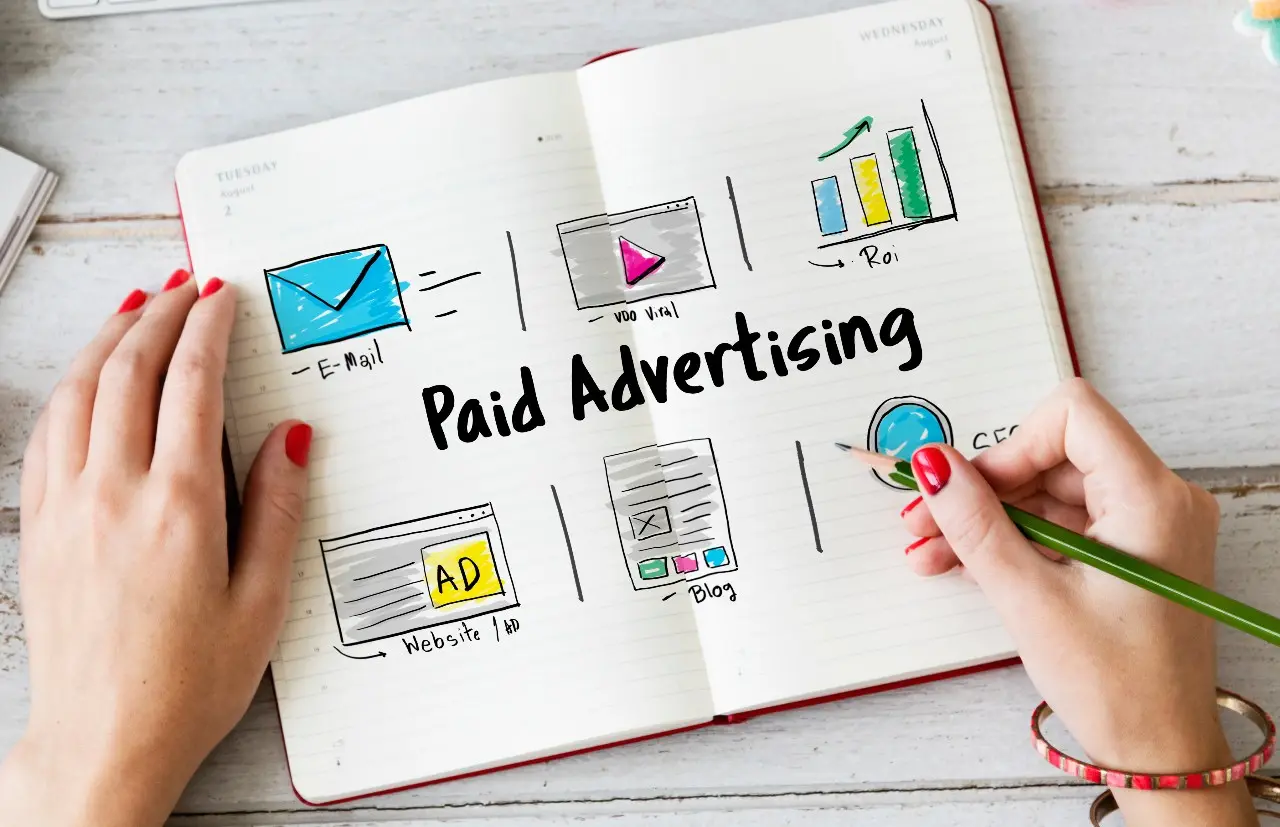Listen to article
Are you ready to take your referral program to the next level? Understanding the latest referral marketing statistics and trends is key to unlocking exponential growth. Today’s successful strategies hinge on key elements, and data-driven insights are more crucial than ever to maximize your ROI.
Did you know that email marketing yields an average ROI of $36 for every dollar spent? Or that a whopping 93% of purchasers consider video essential for trusting a brand. With numbers like that, it’s crucial to stay ahead of the curve.
In this article, we’ll dive into the most relevant referral marketing statistics that will help you optimize your strategies. From the pivotal role of email and the impact of social media to the rise of video content and the creator economy, we’ll explore the trends and data that are shaping the future of referral marketing.
Amplifying Referral Programs with Targeted Email Strategies

Source: Viral Loops
Crafting a successful referral program is more than just incentivizing your customers—it’s about ensuring the message reaches them in a way that drives action. Email marketing, with its unparalleled ROI and advanced personalization capabilities, has become a cornerstone for amplifying referral success. In an era where consumers are bombarded with content, email offers a direct, tailored approach to cut through the noise and nurture meaningful interactions, making it a crucial asset for referral campaigns. Let’s explore the numbers that showcase its value:
- Email automation is a game-changer, with 82% of marketers leveraging it to boost email open rates by 8x. Source
- 59% of marketers confirm email marketing outperforms paid advertising as a lead-generation tool, proving it’s more than twice as effective. Source
- For every dollar spent on email marketing, businesses achieve an impressive ROI of $36. Source
- Behavior-triggered emails hold immense power, generating 10x more revenue than generic campaigns. Source
- 87% of marketers plan to sustain or increase their investment in email marketing, showcasing confidence in its ongoing impact. Source
Key Takeaway
The true magic of email marketing within referral programs lies in its ability to combine reach and relevance. Unlike other channels, email provides a scalable yet personal way to engage your audience, tapping into behavioral insights and creating moments that truly resonate. By aligning your email marketing strategy with robust automation tools and advanced segmentation, you can craft campaigns that not only drive referrals but also foster long-term customer loyalty.
Pro Tip:
Maximize the impact of your email referral campaigns by using dynamic content that adapts to each recipient’s behavior and preferences. Tools like HubSpot, Klaviyo, or Mailchimp allow you to create hyper-personalized experiences. Combine these features with A/B testing to optimize subject lines, call-to-actions, and referral incentives for the highest engagement.
Impact of Personalization, Segmentation, and AI on Email and Referral Success
In the fast-paced world of digital marketing, relevancy is the currency of engagement. As inboxes grow more crowded, generic emails struggle to cut through the noise. Modern email and referral marketing thrive on personalization, segmentation, and AI-powered precision to deliver value-driven experiences that truly resonate with recipients. These tactics don’t just improve open rates—they build trust, foster loyalty, and boost conversions in ways that one-size-fits-all campaigns simply can’t match.
- A staggering 90% of email marketers agree that subscriber segmentation significantly enhances email performance. Source
- Similarly, 90% of marketers report that personalized and targeted messaging improves overall campaign results. Source
- 80% of marketers see notable performance improvements when leveraging personalization techniques, such as dynamic content and real-time updates. Source
- 68% specifically attribute better email performance to the use of dynamic content tailored to recipients. Source
- Personalized subject lines pack a punch, with 77% of email marketers observing improved campaign results when using this strategy. Source
- The practice of subject line personalization is widespread—65% of marketers use it in more than half of their campaigns, while only 9% never utilize it. Source
- Generative AI is changing the game, with an impressive 95% of marketers rating it as effective for email creation, and 54% calling it “very effective.” Source
- The most popular email marketing tactics include list segmentation (51%), personalization (50%), and triggered emails (45%). Source
- 35% of marketers are looking to increase their use of automated emails in the near future, reflecting their growing value. Source
Key Takeaway
The numbers don’t lie—personalization, segmentation, and AI are no longer optional tools for email marketers; they are pivotal for driving meaningful results. By adopting data-driven strategies tailored to audience preferences, brands can foster deeper connections and significantly boost ROI. AI, in particular, holds immense potential to elevate email and referral marketing by automating complex tasks, uncovering actionable insights, and enabling real-time adjustments.
Pro Tip:
To maximize results, pair AI-driven tools with human creativity to strike the right balance between automation and personal touch. Regularly test variables such as dynamic content, timing, and tone to uncover what truly resonates with your audience segments.
Why Mobile-Friendly Referral Marketing is Non-Negotiable
Mobile devices have become the cornerstone of digital interaction, drastically shaping how customers discover and engage with brands. From browsing websites to participating in referral programs, users now expect seamless mobile experiences across every touchpoint. Ignoring mobile optimization in your referral marketing strategy means leaving potential revenue on the table and risking customer frustration in an era where convenience reigns supreme.
- Over half of all online searches and online shopping activities are conducted on mobile phones, emphasizing the critical need for mobile-first strategies. Source
- 67% of mobile users are more likely to make purchases from companies with mobile-friendly websites or location-specific apps. Source
- Smartphones drove over 75% of retail site visits in the U.S. during Q1 2024 and accounted for 66% of total online shopping orders during the same period. Source, Source
- 61% of consumers are more inclined to purchase from websites that deliver a user-friendly mobile experience. Source
- 73% of businesses prioritize optimizing email campaigns for mobile users, recognizing the significant role mobile plays in driving conversions. Source
Key Takeaway
The data speaks volumes: mobile optimization is no longer just a best practice—it’s an expectation. Every touchpoint in your referral marketing efforts, from landing pages to email campaigns, should cater to mobile users. By aligning your strategy with consumer behaviors and preferences, you not only drive conversions but also enhance brand loyalty. Think beyond aesthetics and focus on functional mobile designs—speed, interactivity, and ease-of-use can transform casual visitors into loyal advocates.
Pro Tip:
Mobile technology evolves rapidly, so don’t just set it and forget it. Continuously audit your mobile experiences for factors like load time, readability, and functionality. Tools like Google’s Mobile-Friendly Test or Hotjar’s heatmaps can help you identify pain points and unlock opportunities for optimization. Consistent improvements will keep your referral marketing on pace with customer expectations and industry trends.
Social Media in Amplifying Referral Marketing
Social media isn’t just a tool for building brand awareness—it’s the backbone of modern referral marketing strategies. With its ability to create meaningful connections, amplify content reach, and drive measurable results, social media platforms offer B2B marketers unparalleled opportunities to tap into their audience’s networks. When used strategically, social media channels can help businesses not only distribute content effectively but also foster trust and encourage valuable referrals, especially in a market increasingly driven by peer recommendations.
- 95% of B2B marketers create content specifically for social media, with 91% leveraging it as a major distribution channel. Source
- More than 70% of B2B marketers report improved sales directly attributable to social media efforts within the past year. Source
- Social media ranks as the top channel for both top-of-funnel (50%) and bottom-of-funnel (46%) marketing goals, outperforming other platforms like email. Source
- 41% of B2B marketers cite social media as one of their most effective content delivery formats. Source
- LinkedIn dominates as the most valuable social media platform for 84% of B2B marketers. Source
- 45% of B2B marketers rely on social media sharing as a fundamental key performance indicator (KPI) to measure their content marketing success. Source
- Over a 12-month period, 90% of B2B marketers used social media as their primary channel for distributing content. Source
Key Takeaway
The data leaves no doubt: social media has cemented its place as the go-to platform for driving B2B referrals. According to recent B2B marketing stats, over 78% of B2B marketers say social media is their most effective channel for driving high-quality leads. But its power isn’t in the tools alone—it’s in how they’re wielded. Platforms like LinkedIn provide a goldmine for targeted engagement, enabling marketers to connect with decision-makers and foster trust. Meanwhile, tracking metrics like social sharing can offer deeper insights into how your audience interacts with your content, paving the way for more impactful referral strategies. Marketers who take the time to tailor their messaging to each platform, align strategies with audience behavior, and consistently measure results are positioning themselves for long-term growth in a referral-driven ecosystem.
Pro Tip:
Lean into platform-specific features to expand your reach. For instance, leverage LinkedIn’s advanced targeting options for thought leadership articles, utilize Instagram Stories to humanize your brand, or experiment with Twitter threads to spark conversations. The more platform-native and interactive your content is, the more likely it is to be shared and referred.
Social Media Platforms Fueling Referral Marketing Success: Insights and Analytics

Source: TrueList
The role of social media in referral marketing has evolved far beyond just driving traffic—it’s now about creating immersive, hyper-engaging environments where users actively participate in brand advocacy. Platforms like TikTok, LinkedIn, and YouTube offer powerful opportunities to connect with targeted audiences, leverage new ad formats, and maximize ROI through both organic and paid strategies. To truly capitalize on these channels, your approach needs to blend creative content, data-driven targeting, and platform-specific strategies. Let’s dive into some eye-opening statistics that reveal why these platforms are essential for your referral marketing efforts:
- TikTok users spend an average of 52 minutes per day on the app, showcasing its unmatched ability to hold user attention. Source
- Over two in five Americans now rely on TikTok as a search engine, cementing its role as a discovery-driven platform for businesses. Source
- TikTok also boasts an impressive ad engagement rate, with 38% of users responding positively to advertisements—dwarfing the 4% average for general internet users. Source
- Shoppable video ads, prevalent across platforms like Instagram, YouTube, Pinterest, and TikTok, are driving up conversion rates by integrating interactive purchasing experiences. Source
- On average, individuals use about 6.7 social media platforms each month, emphasizing the growing need for a multi-channel strategy. Source
- Mobile video ads on YouTube achieve a striking 84% higher likelihood of success compared to traditional TV ads, proving their effectiveness in today’s mobile-first world. Source
- LinkedIn holds unparalleled value in the B2B space, with 84% of marketers identifying it as the most critical platform for their efforts. Source
- Over the past 12 months, 72% of B2B brands reported ramping up their presence on LinkedIn. Source
- Simultaneously, many B2B companies are investing in other platforms: 32% increased activity on YouTube, 31% on Instagram, and 22% on Facebook. Source
- Globally, individuals now spend an average of 145 minutes daily on social media, providing ample opportunities for brands to engage with users in moments of high intent. Source
Key Takeaway
Social media has officially become the epicenter of referral marketing opportunities, with platforms like TikTok and LinkedIn leading the charge in audience engagement and ad responsiveness. What sets these platforms apart is their ability to blend entertainment, discovery, and trust—making them more than just advertising channels but integral tools for driving meaningful customer connections. However, success on social media hinges on understanding the unique strengths of each platform and creating tailored strategies for specific audience behaviors.
Pro Tip:
Don’t fall into the trap of spreading your resources too thin. Instead, prioritize the platforms that align most closely with your target demographic and campaign goals. Experiment with diverse ad types like shoppable videos or sponsored posts on TikTok and Instagram while leveraging career-focused thought leadership content on LinkedIn. Measuring key engagement metrics and continuously optimizing ad performance will ensure your referral marketing campaigns achieve sustained impact.
For businesses looking to expand their reach and integrate referral marketing with other digital tactics, exploring B2B website strategy can be a game-changer. A robust website tailored to your target audience complements social media efforts by providing an optimized hub for conversions and nurturing customer relationships.
Social Media’s Impact on Gen Z’s Buying Journey
For Gen Z, social media isn’t just a way to stay connected—it’s the starting point for their buying journey. From discovering the latest trends to making direct purchases, platforms like Instagram have seamlessly integrated shopping into the social experience. As this generation increasingly turns to social media to inform their purchasing decisions, brands that optimize their presence on these platforms can gain a competitive edge in both engagement and revenue.
- 64% of Gen Z individuals prefer to discover products through social media over any other channel. Source
- 71% of U.S. Gen Z social media users (ages 18-26) are likely to make a purchase directly on Instagram. Source
Key Takeaway
Gen Z’s reliance on social media for product discovery and purchasing reinforces the need for a robust, platform-specific strategy. Brands that create authentic, engaging content and make their products easy to purchase directly within apps are poised to thrive. Beyond selling, focus on forming genuine connections through storytelling, user-generated content, and influencer partnerships. Social commerce isn’t just a trend—it’s shaping the future of digital marketing.
Pro Tip:
To maximize engagement with Gen Z, consider using interactive features like polls, quizzes, and Instagram Stories to spark conversation. Combine this with seamless checkout options on platforms like Instagram or TikTok to deliver a frictionless shopping experience that converts.
How Video Fuels Referral Marketing Success
Video has become the cornerstone of effective marketing strategies, especially in referral-driven campaigns. It captivates audiences, simplifies complex messages, and fosters genuine trust—three critical factors when encouraging customers to share your brand with others. Combined with the natural virality of social media sharing, video becomes a powerful tool for amplifying your reach and driving both engagement and referrals.
- A staggering 93% of buyers say video is essential for building trust in a brand. Source
- 88% of buyers have watched a video to research company offerings in the past three months. Source
- 88% of consumers want to see more video content from brands. Source
- Short-form videos (under 90 seconds) retain 50% of viewers, making them ideal for impactful social ads. Source
- 90% of marketers rely on social media as their primary channel for sharing content. Source
- 92% of people who watch videos on their smartphones are inclined to share them with others. Source
- Conversion rates for B2B video marketing average around 4.8%. Source
Key Takeaway
Videos are not just helping marketers increase visibility but are feeding directly into enhanced customer trust, behavior influence, and referral intent. A carefully crafted video does more than educate—when shared across social platforms, it transforms viewers into advocates who voluntarily spread the message.
Pro Tip:
To elevate your referral campaigns, focus on authentic storytelling. Incorporate customer testimonials, employee highlights, or mini customer success stories into your video content. Pair your videos with clear CTAs encouraging social shares and create mobile-optimized formats to capitalize on the high likelihood of sharing via smartphones.
The Creator Economy’s Impact on Modern Marketing Strategies
The rise of the creator economy is reshaping how brands approach digital marketing, particularly when targeting younger, highly engaged audiences like Gen Z. This massive sector emphasizes the growing power of user-generated content (UGC) and influencer partnerships within referral marketing. In this landscape, content quality isn’t just a competitive edge—it’s the foundation for trust, engagement, and long-term brand loyalty.
- In 2024, the creator economy was valued at an estimated $250 billion. Source
- The creator economy is projected to nearly double to $480 billion by 2027. Source
- 83% of marketers prioritize content quality over quantity. Source
Key Takeaway
The explosive growth of the creator economy presents marketers with an unparalleled opportunity to amplify referral marketing through authentic collaborations and UGC. The key? Partner with creators who embody your brand’s values and genuinely connect with their audiences. By focusing on producing high-quality, relatable content—tailored to the preferences of your target audience—you not only boost engagement but also elevate brand trust.
Pro Tip:
Invest time in vetting creators for audience alignment and engagement metrics rather than just follower count. A creator with a smaller, loyal audience may drive more meaningful results than one with a large but passive following.
Why Organic Search is the Cornerstone of B2B Referral Success
In the B2B space, where decisions often involve thorough research and multiple stakeholders, organic search plays a pivotal role in how buyers discover and evaluate solutions. A robust presence in search results isn’t just about visibility—it’s about being present in the exact moments when potential customers are actively seeking answers to their challenges. For businesses aiming to leverage referral marketing strategies, mastering organic search can amplify their reach and credibility.
- A striking 66% of B2B buyers rely on internet search results to gather information before making a purchase choice. This makes organic search significantly more popular than online ads (35%) and social media (23%). Source
Key Takeaway
This insight reveals a critical opportunity for marketers to align their referral strategies with buyer behavior. A well-optimized search strategy ensures you’re not just part of the conversation but leading it when buying decisions are being shaped.
Pro Tip:
Invest in content that’s not only rich in SEO but also hyper-relevant to your audience. Incorporate resources like case studies, how-to guides, and industry insights that solve real problems for your target market. This isn’t just about ranking—it’s about building trust with potential buyers in their moments of need. Leveraging digital marketing strategies for small businesses can help optimize your approach, ensuring your referral marketing efforts are as effective as possible.
Conclusion
Referral marketing has evolved into a multifaceted strategy, blending time-tested techniques with cutting-edge technology to deliver results. From the precision of email automation and AI-driven personalization to the undeniable impact of mobile optimization and video content, the data speaks for itself: referral marketing is an indispensable tool for businesses seeking sustainable growth. Each statistic shared here highlights a key opportunity to refine your approach, whether through segmenting email lists, leveraging social platforms like LinkedIn and TikTok, or embracing the creator economy.
The takeaway? Success in referral marketing isn’t just about following trends; it’s about aligning these trends with your brand’s unique goals and audience needs. By prioritizing personalization, mobile-first experiences, and high-quality content, you can foster deep connections with your audience, turning customers into advocates and advocates into your most powerful growth drivers.
Ready to boost your traffic and grow your website? Your customers are looking for you, and our SEO and email marketing services can help you get found and stay top-of-mind. Don’t wait—let’s create a strategy that works for you.
About B2B Email Marketing Statistics Explained with Fresh Data
This guide was written by the Scopic Studios team and reviewed by Araksya Hakobjanyan, SEO Lead at Scopic Studios.
Scopic Studios delivers exceptional and engaging content rooted in our expertise across marketing and creative services. Our team of talented writers and digital experts excel in transforming intricate concepts into captivating narratives tailored for diverse industries. We’re passionate about crafting content that not only resonates but also drives value across all digital platforms.
Note: This feature blog’s image are sourced from Freepik.














































































































































































































































